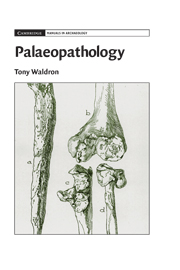Book contents
- Frontmatter
- Contents
- List of Figures
- Preface
- 1 Introduction and Diagnosis
- 2 Bone Metabolism and Pathology
- 3 Diseases of Joints, Part 1
- 4 Diseases of Joints, Part 2
- 5 Bone forming and DISH
- 6 Infectious Diseases
- 7 Metabolic Diseases
- 8 Trauma
- 9 Tumours
- 10 Disorders of Growth and Development
- 11 Soft Tissue Diseases
- 12 Dental Disease
- 13 An Introduction to Epidemiology
- Select Bibliography
- Index
- References
4 - Diseases of Joints, Part 2
Published online by Cambridge University Press: 05 June 2012
- Frontmatter
- Contents
- List of Figures
- Preface
- 1 Introduction and Diagnosis
- 2 Bone Metabolism and Pathology
- 3 Diseases of Joints, Part 1
- 4 Diseases of Joints, Part 2
- 5 Bone forming and DISH
- 6 Infectious Diseases
- 7 Metabolic Diseases
- 8 Trauma
- 9 Tumours
- 10 Disorders of Growth and Development
- 11 Soft Tissue Diseases
- 12 Dental Disease
- 13 An Introduction to Epidemiology
- Select Bibliography
- Index
- References
Summary
The joint diseases can be simply divided into those in which the major feature is the proliferation of new bone and those in which the loss of bone is the most striking feature; the latter are collectively known as the erosive arthropathies. A simplified family tree of the joint diseases showing those that are most likely to be found in the skeleton is shown in Figure 4.1.
Osteoarthritis is the archetypal proliferative joint disease but there are many different erosive joint diseases, including an erosive form of OA. However, only a small number of the erosive arthropathies are likely to be encountered during the examination of a skeletal assemblage and it is these that will be discussed here. The most characteristic of the erosive joint diseases is rheumatoid arthritis.
RHEUMATOID ARTHRITIS
Rheumatoid arthritis (RA) is generally considered to have first appeared in the clinical literature in the MD thesis of the French physician Augustin Jacob Landré-Beauvais (1772–1840). The thesis described the clinical findings in a group of nine patients whom Landré-Beauvais attended at the Salpêtrière hospital in Paris. The signs and symptoms differed in a number of ways from those found in other forms of gout, the rubric under which the joint diseases were all included at the time. It was more common in women, involved many joints from the onset and ran a chronic course. Landré-Beauvais was certain that he had discovered a new form of joint disease, which he called primary asthenic gout (goutte asthénique primitive).
- Type
- Chapter
- Information
- Palaeopathology , pp. 46 - 71Publisher: Cambridge University PressPrint publication year: 2008
References
- 1
- Cited by

